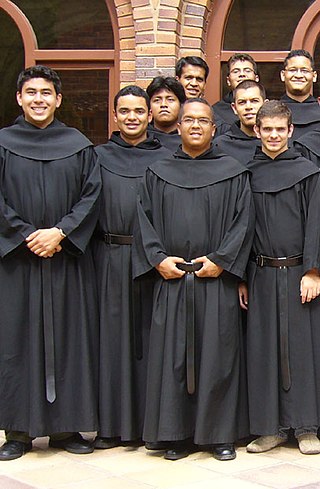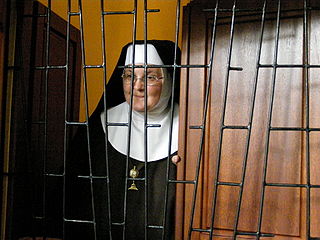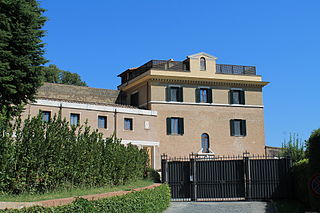
A monastery is a building or complex of buildings comprising the domestic quarters and workplaces of monastics, monks or nuns, whether living in communities or alone (hermits). A monastery generally includes a place reserved for prayer which may be a chapel, church, or temple, and may also serve as an oratory, or in the case of communities anything from a single building housing only one senior and two or three junior monks or nuns, to vast complexes and estates housing tens or hundreds. A monastery complex typically comprises a number of buildings which include a church, dormitory, cloister, refectory, library, balneary and infirmary, and outlying granges. Depending on the location, the monastic order and the occupation of its inhabitants, the complex may also include a wide range of buildings that facilitate self-sufficiency and service to the community. These may include a hospice, a school, and a range of agricultural and manufacturing buildings such as a barn, a forge, or a brewery.

A nun is a woman who vows to dedicate her life to religious service and contemplation, typically living under vows of poverty, chastity, and obedience in the enclosure of a monastery or convent. The term is often used interchangeably with religious sisters who do take simple vows but live an active vocation of prayer and charitable work.

A friar is a member of one of the mendicant orders of the Roman Catholic church. There are also friars outside of the Roman Catholic church, such as within the Anglican Communion. The term, first used in the 12th or 13th century, distinguishes the mendicants' itinerant apostolic character, exercised broadly under the jurisdiction of a superior general, from the older monastic orders' allegiance to a single monastery formalized by their vow of stability. A friar may be in holy orders or be a non-ordained brother. The most significant orders of friars are the Dominicans, Franciscans, Augustinians, and Carmelites.

The Poor Clares, officially the Order of Saint Clare, originally referred to as the Order of Poor Ladies, and also known as the Clarisses or Clarissines, the Minoresses, the Franciscan Clarist Order, and the Second Order of Saint Francis, are members of an enclosed order of nuns in the Roman Catholic Church. The Poor Clares were the second Franciscan branch of the order to be established. Founded by Clare of Assisi and Francis of Assisi on Palm Sunday in the year 1212, they were organized after the Order of Friars Minor, and before the Third Order. As of 2011, there were over 20,000 Poor Clare nuns in over 75 countries throughout the world. They follow several different observances and are organized into federations.

The term third order signifies, in general, lay members of Christian religious orders, who do not necessarily live in a religious community such as a monastery or a nunnery, and yet can claim to wear the religious habit and participate in the good works of a great order. Roman Catholicism, Lutheranism and Anglicanism all recognize third orders.
The Benedictine Abbey of Regina Laudis was founded in 1947 by Mother Benedict Duss, O.S.B. and Mother Mary Aline Trilles de Warren, O.S.B. in Bethlehem, Connecticut. This monastic foundation was one of the first houses of contemplative Benedictine nuns in the United States. Mother Benedict and Mother Mary were both nuns of the Benedictine Abbey of Notre Dame de Jouarre in France. Mother Benedict had grown up in Paris and studied medicine at the Sorbonne. Until the monastery of Regina Laudis gained abbatial status, it was a dependent priory of Jouarre Abbey, a 7th-century monastery northeast of Paris, France.

Anglican religious orders are communities of men or women in the Anglican Communion who live under a common rule of life. The members of religious orders take vows which often include the traditional monastic vows of poverty, chastity and obedience, or the ancient vow of stability, or sometimes a modern interpretation of some or all of these vows. Members may be laity or clergy, but most commonly include a mixture of both. They lead a common life of work and prayer, sometimes on a single site, sometimes spread over multiple locations. Though many Anglicans are members of religious orders recognized by the Anglican Communion, others may be members of ecumenical Protestant or Old Catholic religious orders while maintaining their Anglican identity and parochial membership in Anglican churches.
St Mary's Abbey, also known as Malling Abbey, is an abbey of Anglican Benedictine nuns located in West Malling, Kent, England. It was founded around 1090 by Gundulf, Bishop of Rochester.

Paul of the Cross, CP was an Italian Catholic mystic, and founder of the Passionists.

Enclosed religious orders or cloistered clergy are religious orders whose members strictly separate themselves from the affairs of the external world. In the Catholic Church, enclosure is regulated by the code of canon law, either the Latin code or the Oriental code, and also by the constitutions of the specific order. It is practised with a variety of customs according to the nature and charism of the community in question. This separation may involve physical barriers such as walls and grilles, with entry restricted for other people and certain areas exclusively permitted to the members of the convent. Outsiders may only temporarily enter this area under certain conditions. The intended purpose for such enclosure is to prevent distraction from prayer and the religious life and to keep an atmosphere of silence.
Henry de Beaume, O.F.M., , also known as Hugh Balme, was a Franciscan friar, priest and theologian. He became a supporter of the reform work of Colette of Corbie, among the Poor Clare nuns, which, in turn, led a reform movement of his own branch of the Franciscan Order. He is honored as a Blessed within the Order.

Colette of Corbie, PCC was a French abbess and the foundress of the Colettine Poor Clares, a reform branch of the Order of Saint Clare, better known as the Poor Clares. She is honored as a saint in the Catholic Church. Due to a number of miraculous events claimed during her life, she is venerated as a patron saint of women seeking to conceive, expectant mothers, and sick children.
The Society of Saint Pius X has close links with several religious institutes, chiefly in France.
The Dominican Nuns of the Perpetual Rosary are a religious institute founded in 1880 in Calais, France, by Father Damien-Marie Saintourens, Mother Rose of Saint Mary Werhle and Mother Mary Imelda Gauthier, all of them from the Order of the Preachers.

The Third Order of Saint Dominic, also referred to as the Lay Fraternities of Saint Dominic or Lay Dominicans since 1972, is a Catholic third order which is part of the Dominican Order.
The Passionist nuns are an order of nuns in the Roman Catholic Church. It was the second Passionist order to be established, founded in 1771 by St. Paul of the Cross and Faustina Gertrude Constantini, known in religion as Mother Mary Crucified. The Passionist nuns are a cloistered, contemplative community.
The Colettine Poor Clares are a reform branch of the Order of St. Clare, founded by Clare of Assisi in Italy in 1211. They follow the interpretation of the Rule of St. Clare established by Saint Colette in 1410, originally a French hermit and member of the Third Order of St. Francis.

The Mater Ecclesiae Monastery is a monastery in Vatican City. It was founded around 1990 by Pope John Paul II as a monastery for cloistered nuns. Various cloistered orders are invited to take up residence for a time. From his resignation in 2013 until his death in 2022, it served instead as the residence of Pope Benedict XVI. In 2023, Pope Francis returned it to its monastic purpose with an invitation to Benedictine nuns of the Abbey of St. Scholastica in Victoria, Argentina.













